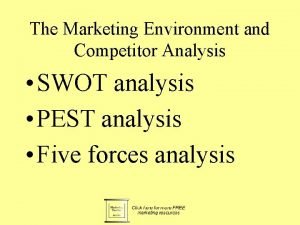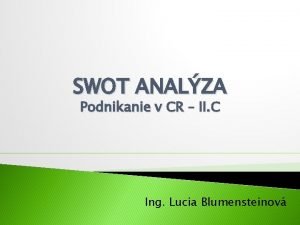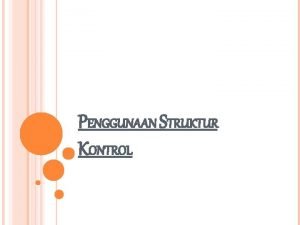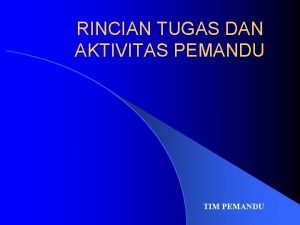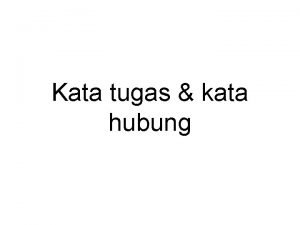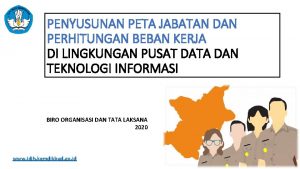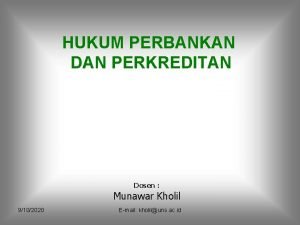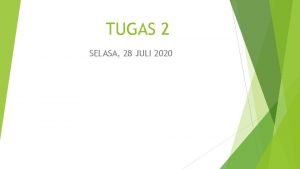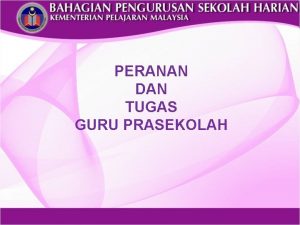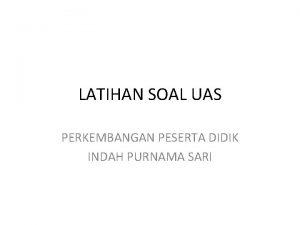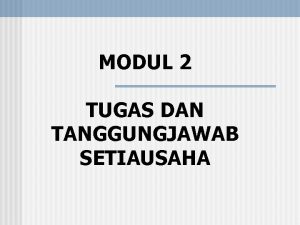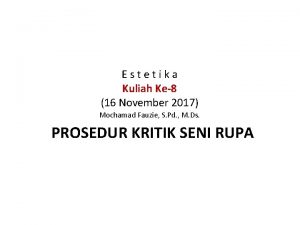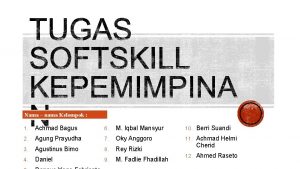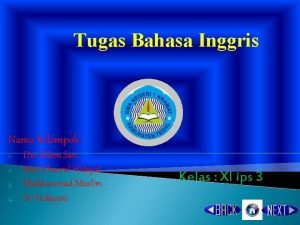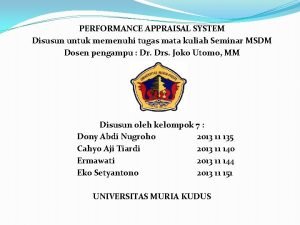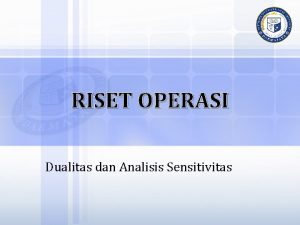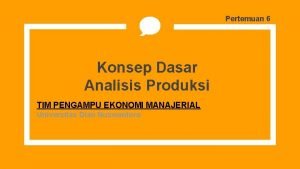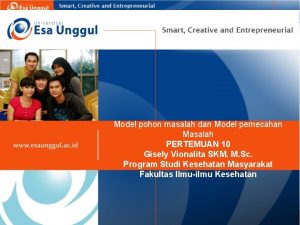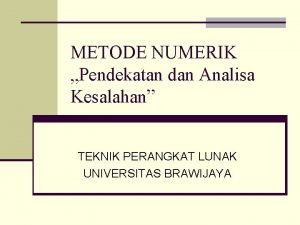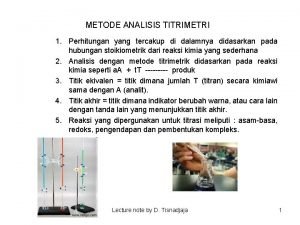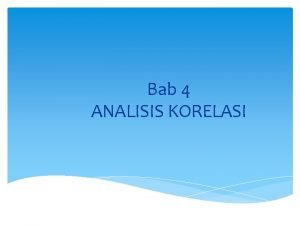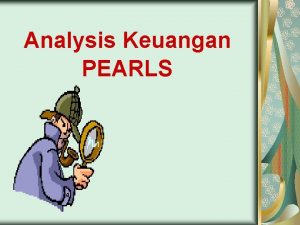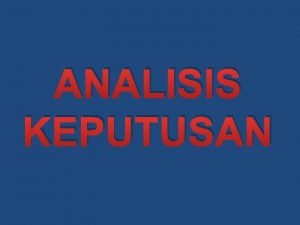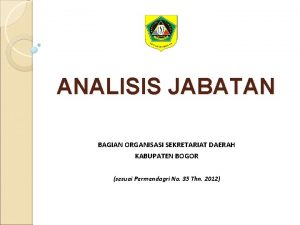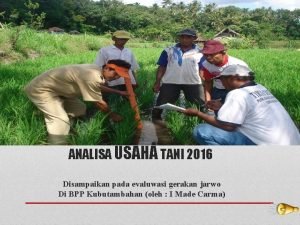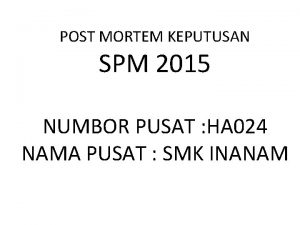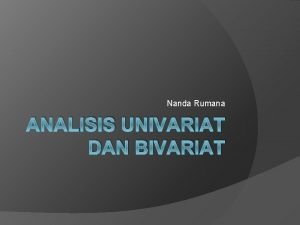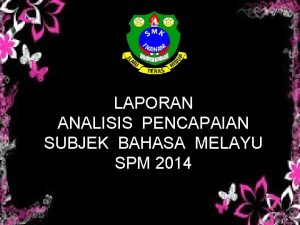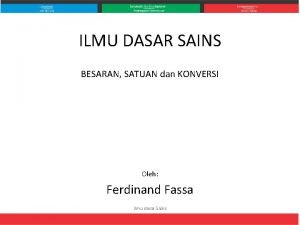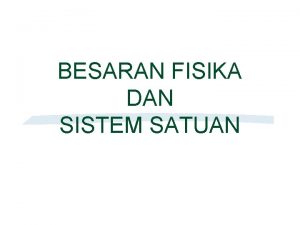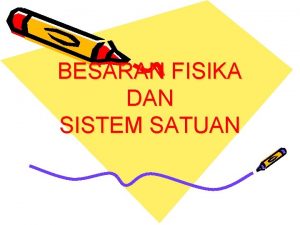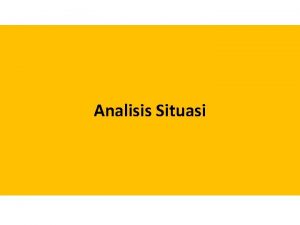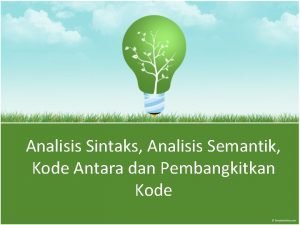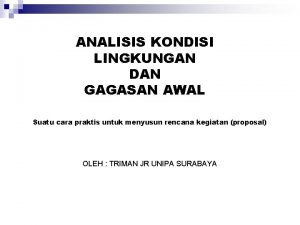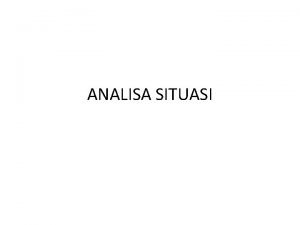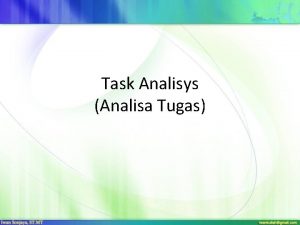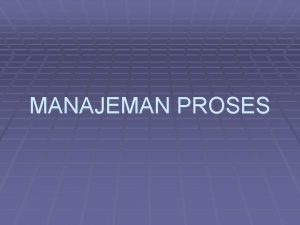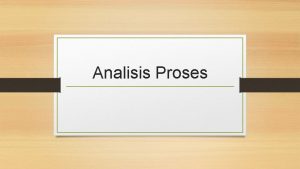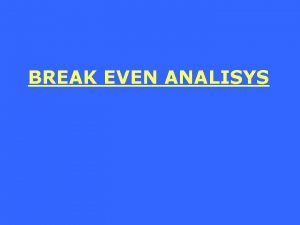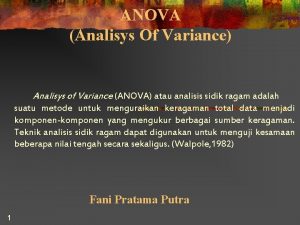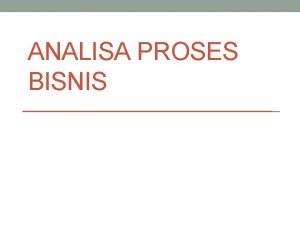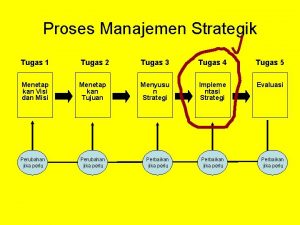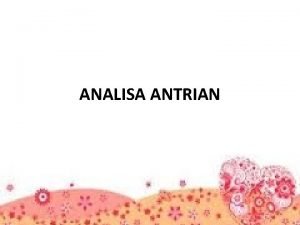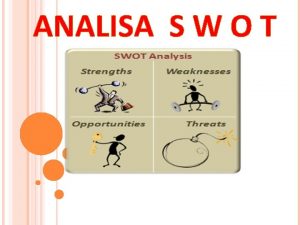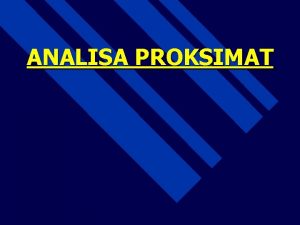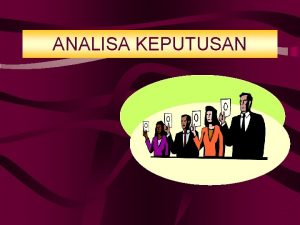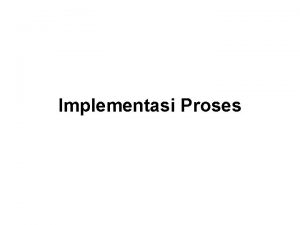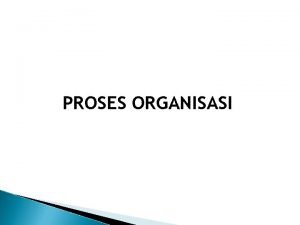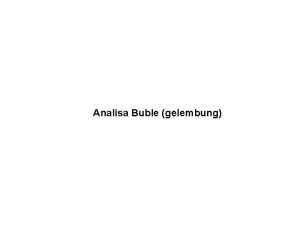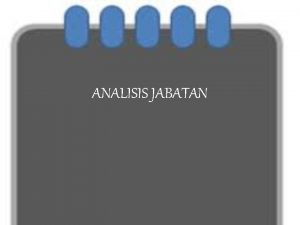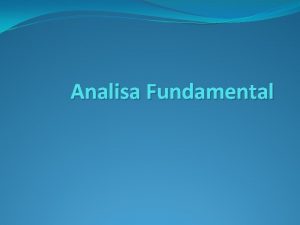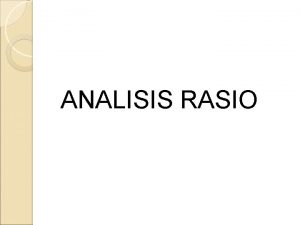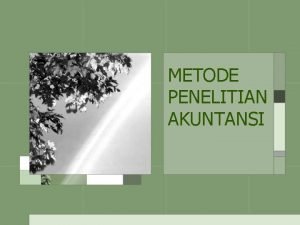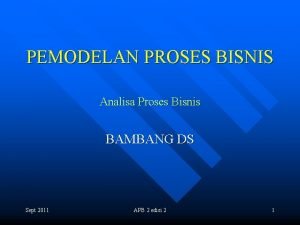Task Analisys Analisa Tugas Task Analisis Proses untuk










































- Slides: 42

Task Analisys (Analisa Tugas)

• Task Analisis : Proses untuk menganalisis cara manusia melakukan pekerjaanya, hal-hal yang mereka kerjakan, hal-hal yang mereka kenai tindakan, dan hal-hal yang perlu mereka ketahui • Keluaran dari task Analysis : Breakdown dari task yang dilakukan oleh manusia, hal-hal yang mereka gunakan, rencana dan tindakan yang biasa dilakukan untuk penyelesaian task • Task Analisis tidak pernah selesai , Tetapi digunakan untuk mempermudah pembangunan antar muka yang mendukung cara kerja manusia yang diinginkan

Mengapa Perlu Task Analysis? • Untuk memasukan elemen manusia secara langsung pada perancangan , secara sistematis dan terbuka sehinggadapat diperiksa dengan sangat teliti • Elemen manusia harus di optimasi dan potensi kesalahan harus diminimasi

What is Task Analysis? Methods to analyse people's jobs: – what people do – what things they work with – what they must know

Istilah-istilah dalam Task Analysis • Sasaran (external task) : adalah keadaan sistem yang ingin dicapai manusia – Contoh : Menulis surat, pergi ke toko • Task (internal task) : Himpunan terstruktur dari aktivitas yang dibutuhkan, digunakan atau dipercayai penting untuk mencapai sasaran menggunakan perangkat tertentu – Menulis (mengetik) perintah pada keyboard • Aksi (action) : adalah task yang tidak mengandung pemecahan persoalan atau komponen struktur kendali – Contoh ; Memindahkan pointer, menekan kunci • Rencana (method) terdiri atas sejumlah task atau aksi yang dihubungkan dalam urutan

Penggunaan Task Analysis • Manual dan Pengajaran – Mengajarkan cara melakukan task – Menyusun manual atau materi ajar – Membantu user menjelaskan sisitem ke orang lain • Menangkap kebutuhan dan merancang sistem – Membantu perancangan sistem baru – Membantu perancang dalam memilih model internal untuk sistem yang sesuai dengan harapan user – Meramalkan sistem baru • Merancang Antar Muka (detail) – Mengklasifikasi task atau objek yang digunakan dalam perancangan baru – Menghubungkan antara objek dan action (OOP)

general method • observe • collect unstructured lists of words and actions • organize using notation or diagrams

Differences from other techniques Systems analysis system design Cognitive models vs. - focus vs. Task analysis the user Task analysis internal mental state - focus - external actions practiced `unit' task - focus - whole job

Contoh Task Analysis : Membersihkan kamar • Ambil vacuum cleaner • Tancapkan vacuum cleaner ke alat penghubung listrik • Bersihkan kamar • Jika kantong vacuum cleaner penuh, kosongkan • Pasang kembali vacuum cleaner dan segala peralatan pendukungnya

Untuk melakukan task : membersihkan kamar user harus : • • • Vacuum cleaner Alat pendukung (koneksi listrik) Kotak debu Lemari Ruangan dll

Teknik Task Analysis • Dekomposisi Tugas • Analisi berbasis pengetahuan • Teknik Berbasis relasi entitas

Dekomposisi Tugas • Hierarchical Task Analysis (HTA) : adalah metode yang sering digunakan dalam pendekatan dekomposisi task • HTA : deskripsi task dalam lingkup operasi (hal yang dilakukan manusia dalam mencapai sasaran), dan rencana (Pernyataan/kondisi saat tiap himpunan operasi harus dijalankan untuk mencapai sasaran operasi) • Keluaran HTA adalah hirarki task dan sub task serta rencana yang menggambarkan urutan dan konndisi yan memungkinkan subtask berjalan

Proses Pembuatan HTA

Contoh HTA : Pengeditan Teks

Contoh HTA : Membuat secangkir Teh

Contoh HTA : Membuat beberapa cangkir Teh

Desain Antarmuka Contoh 1. Reservasi Hotel 2. Pendaftaran mahasiswa baru 3. Rental DVD

Requirement Functional : berkaitan dengan fungsi Data : data yang terlibat dalam sistem Environmental : konteks dan lingkungan sekitar ex: ATM

Pengumpulan Data Interview Focus Group Kuisioner Observasi Pelajari dokumentasi Cari produk yang mirip

Task Description Skenario : deskripsi narasi yang informal untuk jelaskan kegiatan manusia dalam sebuah cerita Use case : fokus pada user-system interaction. Berkaitan dengan fungsi yang disediakan sistem untuk user

Knowledge Based Analyses Focus on: Objects – used in task Actions – performed + Taxonomies – represent levels of abstraction

Knowledge–Based Example … motor controls steering wheel, indicators engine/speed direct ignition, accelerator, foot brake gearing clutch, gear stick lights external headlights, hazard lights internal courtesy light wash/wipers front wipers, rear wipers washers front washers, rear washers heating temperature control, air direction, fan, rear screen heater parking hand brake, door lock radio numerous!

Entity-Relationship Techniques Focus on objects, actions and their relationships Similar to OO analysis, but … – includes non-computer entities – emphasises domain understanding not implementation Running example ‘Vera's Veggies’ – a market gardening firm owner/manager: Vera Bradshaw employees: Sam Gummage and Tony Peagreen various tools including a tractor `Fergie‘ two fields and a glasshouse new computer controlled irrigation system

Objects Start with list of objects and classify them: Concrete objects: simple things: spade, plough, glasshouse Actors: human actors: Vera, Sam, Tony, the customers what about the irrigation controller? Composite objects: sets: the team = Vera, Sam, Tony tuples: tractor may be < Fergie, plough >

Attributes To the objects add attributes: Object Pump 3 simple – irrigation pump Attributes: status: on/off/faulty capacity: 100 litres/minute N. B. need not be computationally complete

Actions List actions and associate with each: agent – who performs the actions patient – which is changed by the action instrument – used to perform action examples: Sam (agent) planted (action) the leeks (patient) Tony dug the field with the spade (instrument)

Actions (ctd) implicit agents – read behind the words `the field was ploughed' – by whom? indirect agency – the real agent? `Vera programmed the controller to irrigate the field' messages – a special sort of action `Vera told Sam to. . . ' rôles – an agent acts in several rôles Vera as worker or as manager

example – objects and actions Object Sam human actor Actions: S 1: drive tractor S 2: dig the carrots Object Vera human actor Object glasshouse simple Attribute: humidity: 0 -100% – the proprietor Actions: as worker V 1: plant marrow seed V 2: program irrigation controller Actions: as manager V 3: tell Sam to dig the carrots Object the men composite Comprises: Sam, Tony Object Irrigation Controller non-human actor Actions: IC 1: turn on Pump 1 IC 2: turn on Pump 2 IC 3: turn on Pump 3 Object Marrow simple Actions: M 1: germinate M 2: grow

Events … when something happens • performance of action ‘Sam dug the carrots’ • spontaneous events ‘the marrow seed germinated’ ‘the humidity drops below 25%’ • timed events ‘at midnight the controller turns on’

Relationships • object-object social - Sam is subordinate to Vera spatial - pump 3 is in the glasshouse • action-object agent (listed with object) patient and instrument • actions and events temporal and causal ‘Sam digs the carrots because Vera told him’ • temporal relations use HTA or dialogue notations. show task sequence (normal HTA) show object lifecycle

example – events and relations Events: Ev 1: humidity drops below 25% Ev 2: midnight Relations: object-object location ( Pump 3, glasshouse ) location ( Pump 1, Parker’s Patch ) Relations: action-object patient ( V 3, Sam ) – Vera tells Sam to dig patient ( S 2, the carrots ) – Sam digs the carrots. . . instrument ( S 2, spade ) –. . . with the spade Relations: action-event before ( V 1, M 1) – the marrow must be sown before it can germinate triggers ( Ev 1, IC 3 ) – when humidity drops below 25%, the controller turns on pump 3 causes ( V 2, IC 1 ) – the controller turns on the pump because Vera programmed it

DVD Rental Store Gunakan Use Case untuk mengidentifikasi user requirement, dan task flow Sewa Pengembalian Kasir Pengembalian Print Remainder 32

Task A task is a set of physical and cognitive procedures that when combined serve to achieve a particular goal. Characteristics that help define a task include: • The starting and ending conditions • The input event or stimuli that initiates the need for the task goal • The output or results required and/or achieved • The procedures, events, or items required to accomplish the task goal, including: • Decisions or choices • Actions or transformations • Feedback information throughout task performance • Error indicators for inappropriate actions or choices • Knowledge to be retrieved (from memory or information sources) Task Flow: • A task flow is a written or graphical representation of the interrelationships between tasks, particularly with regard to order of performance. Task flows often include information about the procedures, events, or items required to accomplish each task goal. Task flows are useful for identifying task scenarios for usability testing and also for identifying the locations for task controls and 33 displays.

User Task Kasir Uraian Pekerjaan / Task: • Entry Penyewaan VCD • Menerima pembayaran • Mengecek Apakah sudah terlambat • Membuat Remainder • Entry Pengembalian • Perhitungan Denda • Pengiriman Remainder 34

Use Model A use model is the general, overall system design concept into which the tasks, task terminology, and task navigation are built. It is the environment, or metaphor, in which the user must identify and access the system functions. The use model involves the placement and layout of the functional areas of the system and the logical and inherent methods for navigating between the functional areas. Example: A software interface contains menubars, toolbars, work areas, dialog boxes, backgrounds, and status information. A properly designed use model assures that each of these components is properly placed within the system such that a user can easily understand how the information is arranged, what actions they can perform, how to get from one place to another, how to interpret terminology, and where they are within the system. Briefly, a use model is said to be the mapping of the user's cognitive model onto the system. 35

User Model • Four main patterns/styles – menu – form filling – command language – direct manipulation • Pilih dari empat patterns/styles yang ada sesuai dengan TASK dan User Profile dan GOAL yang hendak dicapai 36

User Model • Untuk kasus Video ini cocok gunakan: – Menu , Karena banyak perbedaan tugas yang harus dikerjakan oleh Kasir – Form Filling, untuk entry sewa, pengembalian 37

Quiz • Buat HTA dari Proses peminjaman buku di perpustakaan

jawaban (1)Pinjam buku di perpus (tujuan) (2)Pergi ke perpustakaan (3) Cari buku yang diperlukan (1)Akses OPAC (2)Akses fasilitas search (3)Masukkan kriteria pencarian (4)Identifikasi buku yang dicari (5)Catat lokasi (4) Ke rak dan ambil buku (5)Bawa buku ke meja sirkulasi

• Pilih satu diantara 2 kasus berikut ini • Kumpulkan

Toko Bangunan Maju Terus • Toko bangunan “Maju Terus” menjual bahan bangunan seperti semen, paku, pasir, cat dll. Setiap melakukan penjualan pada pelanggan dibuatlah nota penjualan dan pembayaran dilakukan secara tunai. Bila ada pelanggan akan membeli barang, dilayani oleh penjaga toko dan pembayaran diberikan pada kasir. Pembelian barang pada supplier juga dilakukan secara tunai. Toko Maju Jaya mempunyai banyak supplier dan setiap supplier mesupply barang yang berbeda. • Buat User Task dan User Model 41

SERVICE ELEKTORNIK “PASTI” • Service Elektronik “Pasti” menerima reparasi barang-barang elektronik seperti Radio, VCD, Televisi dan Tape. Setiap ada pelanggan yang akan memperbaiki barang elektroniknya diterima oleh bagian penerimaan barang dan diberikan bukti reparasi. Setiap barang yang akan direparasi diberikan pada Montir tertentu dan Service Elektronik “Pasti” mempunyai beberapa Montir. Pada saat memperbaiki, bila diperlukan spare part, maka Montir akan meminta spare part dan dicatat oleh bagian Administrasi utk pelanggan mana. Setelah selesai pada bukti reparasi akan ditulis spare part yang digunakan dan biaya reparasinya. • Buat User Task dan User Model 42
 Competitor analisys
Competitor analisys Analysis or analisys
Analysis or analisys Swot analisys
Swot analisys Analisa struktur control untuk mengontrol jalannya program
Analisa struktur control untuk mengontrol jalannya program Tugas pemandu diskusi
Tugas pemandu diskusi Kata yang berfungsi sebagai kata sendi nama dan kata hubung
Kata yang berfungsi sebagai kata sendi nama dan kata hubung Peranan pembesar *
Peranan pembesar * Cara membuat peta jabatan
Cara membuat peta jabatan Tugas tugas bank
Tugas tugas bank Mengidentifikasi bahan serat alam
Mengidentifikasi bahan serat alam Senarai tugas guru prasekolah
Senarai tugas guru prasekolah Bagan lingkungan organisasi
Bagan lingkungan organisasi Soal dan jawaban uas mata kuliah perkembangan peserta didik
Soal dan jawaban uas mata kuliah perkembangan peserta didik Tugas tugas setiausaha
Tugas tugas setiausaha Pada tahap analisis tugas kritikus adalah
Pada tahap analisis tugas kritikus adalah Bagian bagian pipet tetes
Bagian bagian pipet tetes Subordinated group
Subordinated group Nama kelompok dalam bahasa inggris
Nama kelompok dalam bahasa inggris Skp itb
Skp itb Makalah ini dibuat untuk memenuhi tugas
Makalah ini dibuat untuk memenuhi tugas Analisa sensitivitas riset operasi
Analisa sensitivitas riset operasi Konsep dasar analisis faktor produksi
Konsep dasar analisis faktor produksi Gambar pohon masalah
Gambar pohon masalah Kesalahan teknik adalah
Kesalahan teknik adalah Contoh soal titrimetri
Contoh soal titrimetri Korelasi+adalah
Korelasi+adalah Pearls adalah
Pearls adalah Analisis persoalan adalah
Analisis persoalan adalah Contoh laporan analisa dan evaluasi
Contoh laporan analisa dan evaluasi Analisa usaha tani padi 2021
Analisa usaha tani padi 2021 Analisa keputusan spm 2015
Analisa keputusan spm 2015 Analisis data univariat
Analisis data univariat Post mortem bahasa melayu spm
Post mortem bahasa melayu spm Ukuran berat
Ukuran berat Faktor yang mempengaruhi analisis gravimetri
Faktor yang mempengaruhi analisis gravimetri Analisa dimensi
Analisa dimensi Analisa dimensi
Analisa dimensi Contoh analisis situasi masalah kesehatan
Contoh analisis situasi masalah kesehatan Example of syntax analysis
Example of syntax analysis Faktor analisis pasar
Faktor analisis pasar Gagasan awal
Gagasan awal Analisa situasi adalah
Analisa situasi adalah Analisa akar masalah
Analisa akar masalah
